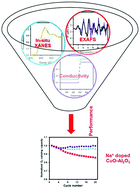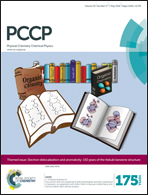Na+ doping induced changes in the reduction and charge transport characteristics of Al2O3-stabilized, CuO-based materials for CO2 capture†
Abstract
Chemical looping combustion (CLC) and chemical looping with oxygen uncoupling (CLOU) are emerging CO2 capture technologies that could reduce appreciably the costs associated with the capture of CO2. In CLC and CLOU, the oxygen required to combust a hydrocarbon is provided by a solid oxygen carrier. Among the transition metal oxides typically considered for CLC and CLOU, copper oxide (CuO) stands out owing to its high oxygen carrying capacity, exothermic reduction reactions and fast reduction kinetics. However, the low Tammann (sintering) temperature of CuO is a serious drawback. In this context, it has been proposed to support CuO on high Tammann temperature and low cost alumina (Al2O3), thus, reducing the morphological changes occurring over multiple CLC or CLOU redox cycles and stabilizing, in turn, the high activity of CuO. However, in CuO–Al2O3 systems, phase stabilization and avoiding the formation of the CuAl2O4 spinel is key to obtaining a material with a high redox stability and activity. Here, we report a Na+ doping strategy to phase stabilize Al2O3-supported CuO, yielding in turn an inexpensive material with a high redox stability and CO2 capture efficiency. We also demonstrate that doping CuO–Al2O3 with Na+ improves the oxygen uncoupling characteristics and coke resistance of the oxygen carriers. Utilizing in situ and ex situ X-ray absorption spectroscopy (XAS), the local structure of Cu and the reduction pathways of CuO were determined as a function of the Na+ content and cycle number. Finally, using 4-point conductivity measurements, we confirm that doping of Al2O3-supported CuO with Na+ lowers the activation energy for charge transport explaining conclusively the improved redox characteristics of the new oxygen carriers developed.


 Please wait while we load your content...
Please wait while we load your content...